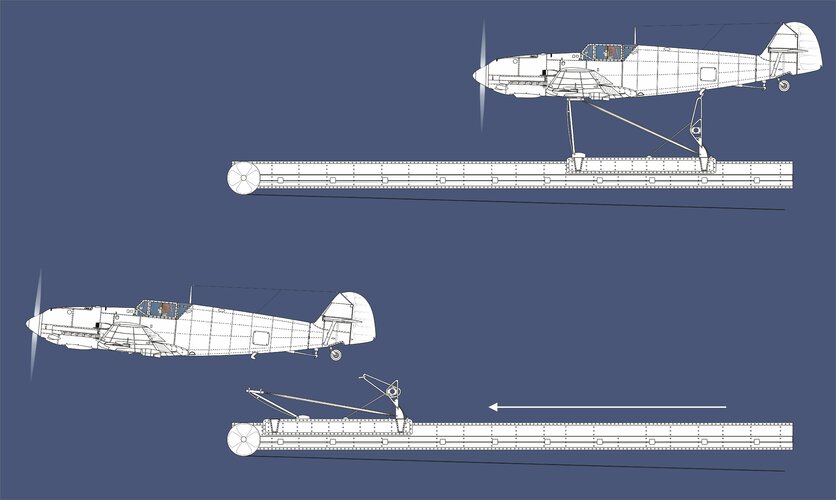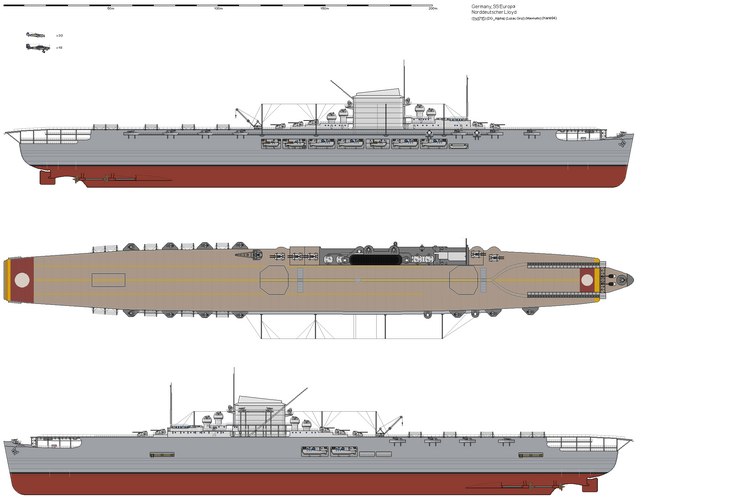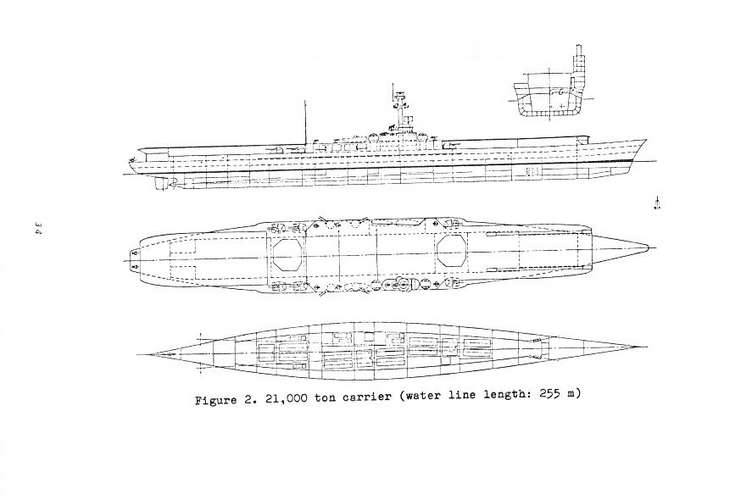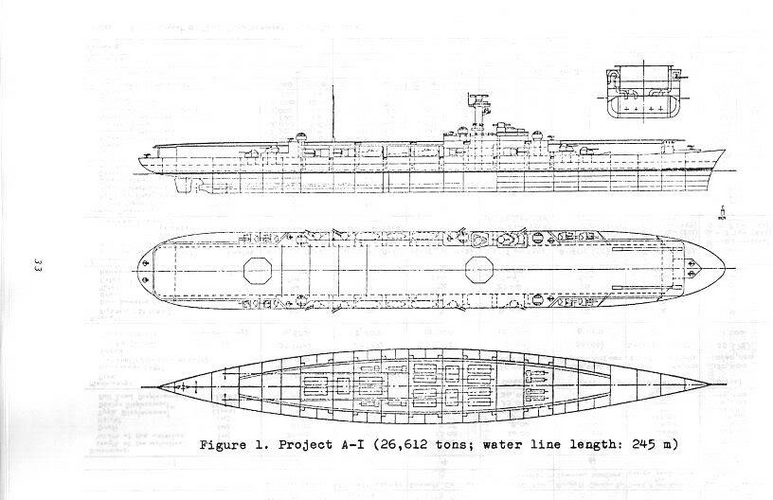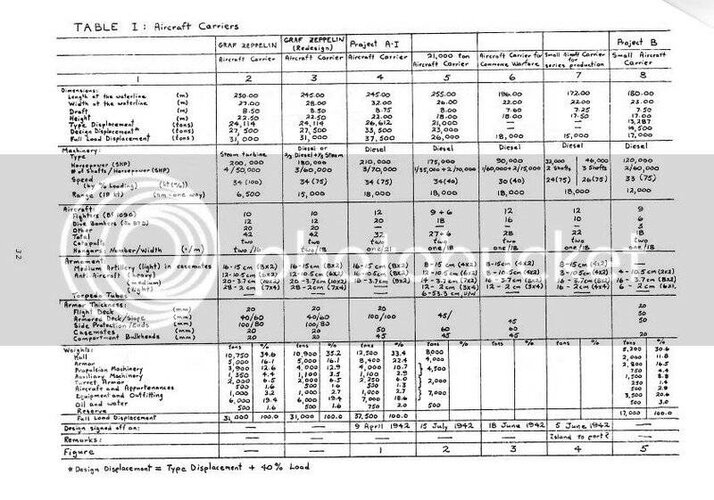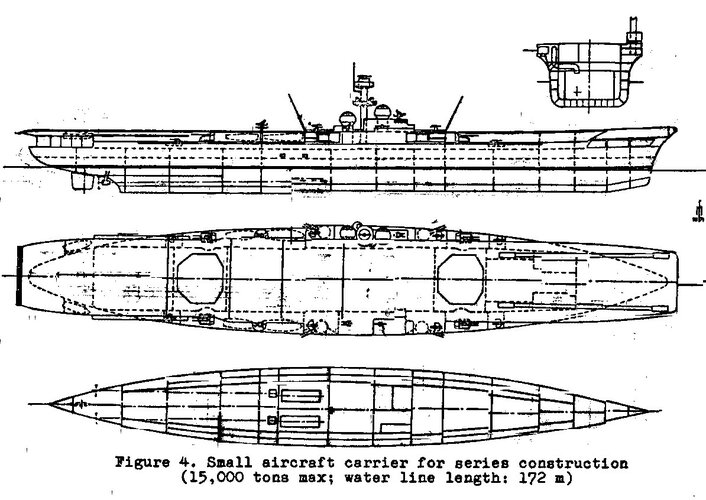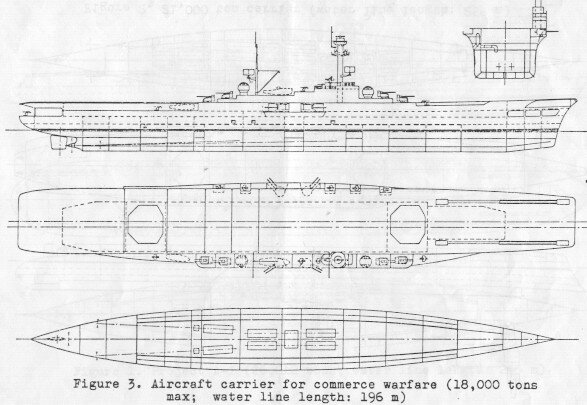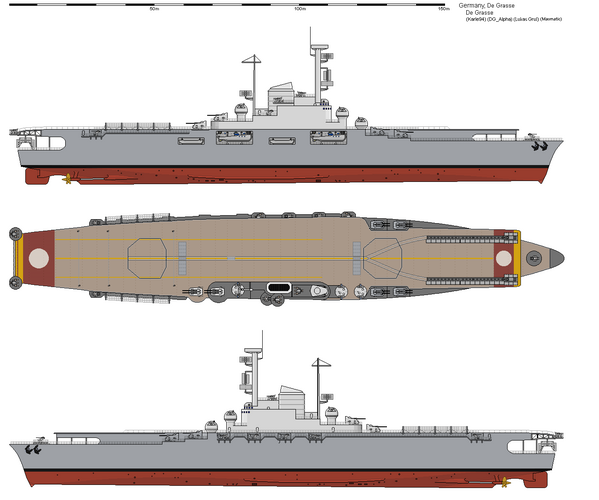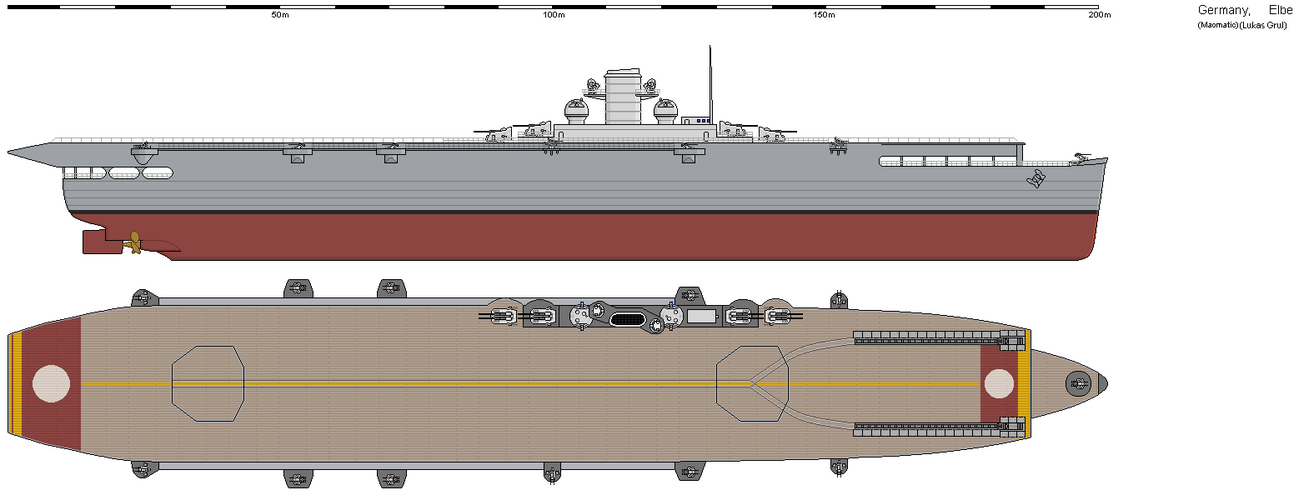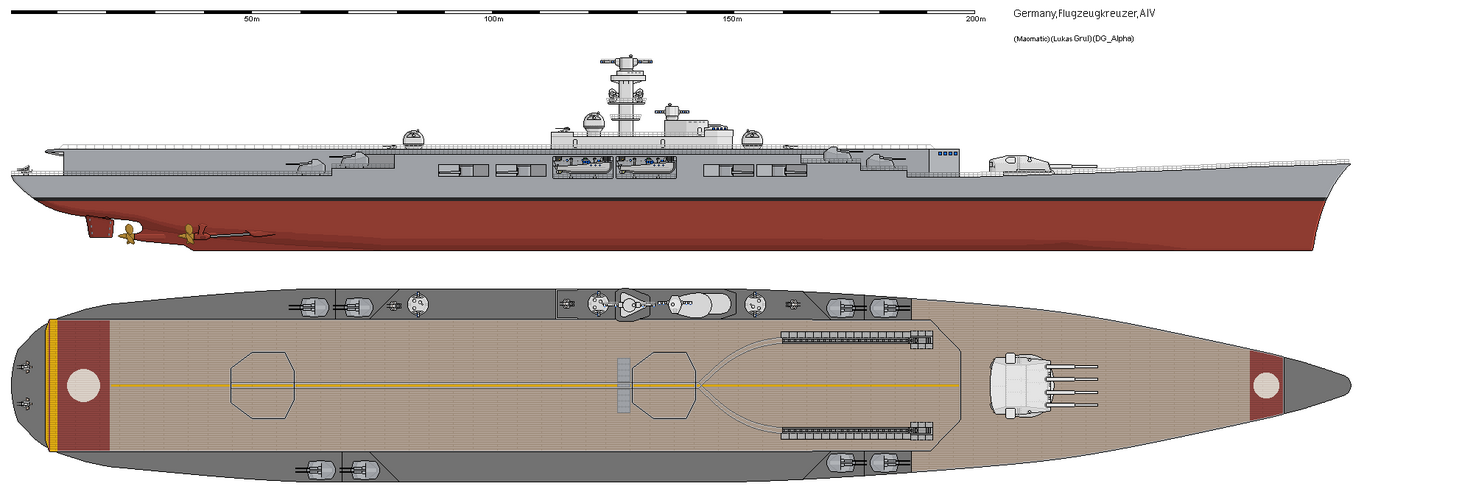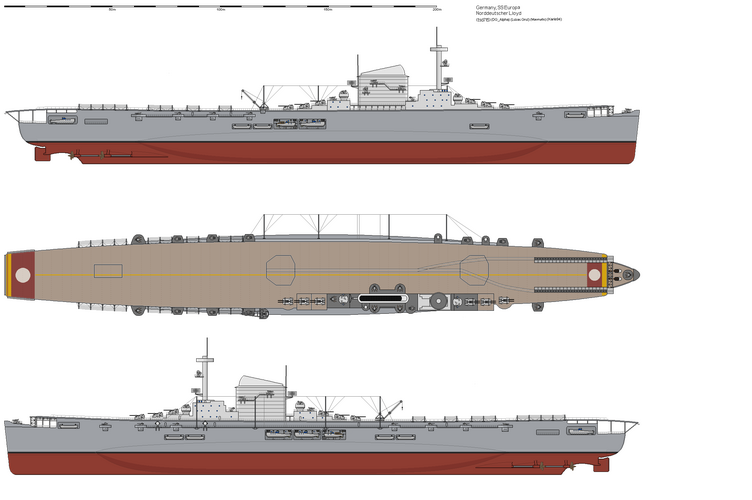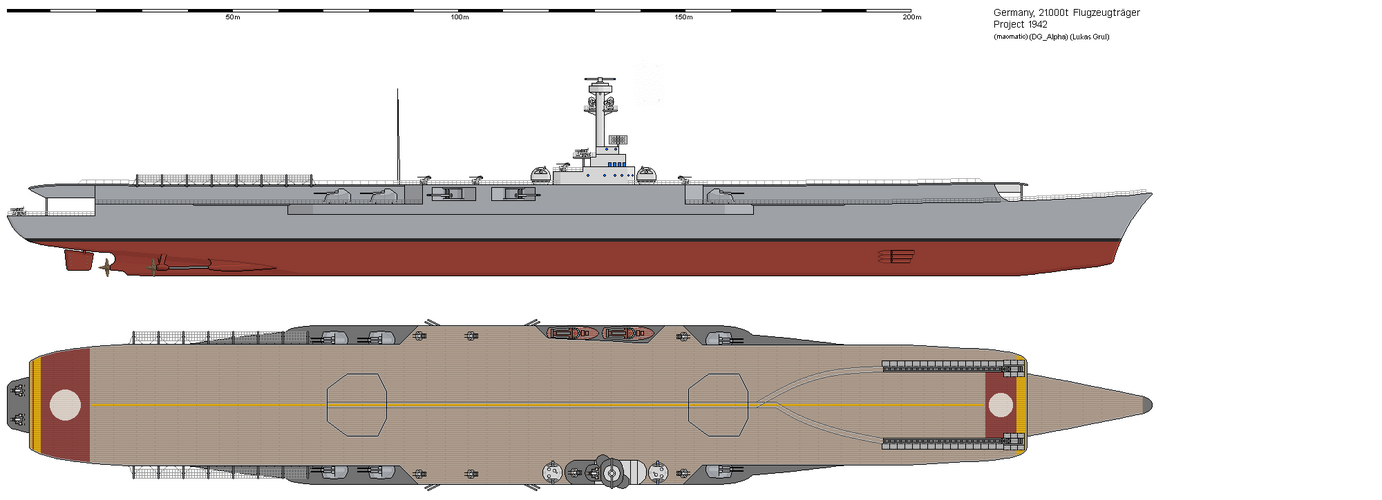They're rare given how obscure Europa is (or lack of interests from modelers), this is one i know so far.Do you know if there are any other 3D models or renders of Europa than those that are in wows forum about almost german Cv´s?
You are using an out of date browser. It may not display this or other websites correctly.
You should upgrade or use an alternative browser.
You should upgrade or use an alternative browser.
Kriegsmarine - KM, Aircraft Carrier Projects
- Thread starter lukasgrul
- Start date
lukasgrul
ACCESS: Confidential
- Joined
- 15 May 2021
- Messages
- 129
- Reaction score
- 112
I don´t understand why this isn´t more popular project. When H-44 is very popular even when it isn´t realistic at all, the europa would be the biggest ship in battle of atlantic and that sounds cool. I hope anybody would make it.They're rare given how obscure Europa is (or lack of interests from modelers), this is one i know so far.Do you know if there are any other 3D models or renders of Europa than those that are in wows forum about almost german Cv´s?
MrMemerMan
ACCESS: Restricted
- Joined
- 11 June 2020
- Messages
- 47
- Reaction score
- 41
Many German Carrier designs weren't serious considered. Also the Luftwaffe wasn't interested in making Navalized planes so there is also that.I don´t understand why this isn´t more popular project. When H-44 is very popular even when it isn´t realistic at all, the europa would be the biggest ship in battle of atlantic and that sounds cool. I hope anybody would make it.They're rare given how obscure Europa is (or lack of interests from modelers), this is one i know so far.Do you know if there are any other 3D models or renders of Europa than those that are in wows forum about almost german Cv´s?
_Sarcasticat_
Die Katze.
- Joined
- 16 April 2020
- Messages
- 364
- Reaction score
- 351
I think some of the same reasons that make Aquila not as popular as, say, the Littorio class apply here.I don´t understand why this isn´t more popular project. When H-44 is very popular even when it isn´t realistic at all, the europa would be the biggest ship in battle of atlantic and that sounds cool. I hope anybody would make it.They're rare given how obscure Europa is (or lack of interests from modelers), this is one i know so far.Do you know if there are any other 3D models or renders of Europa than those that are in wows forum about almost german Cv´s?
I still think Europa is interesting, even if it has to compete with the aura that seems to magically come with the H-class designs.
Perhaps she might have been even more interesting if her rebuild was as comprehensive as Aquila's.
- Joined
- 1 February 2011
- Messages
- 2,929
- Reaction score
- 3,594
There were some:
Small Aircraft Carrier
Seydlitz
Jade
De Grasse
21000t Design
Commerce Warfare Aircraft Carrier
Small Aircarft Carrier Project A
Small Aircarft Carrier Project B
Ausonia
Graf Zeppelin
Europa
Flugzeugträger A I
Flugdeckkreuzer E IV
Flugdeckkreuzer E V
Gross Flugzeugkreuzer A II
Gross Flugzeugkreuzer A IIa
Gross Flugzeugkreuzer A III
Gross Flugzeugkreuzer A IV
Small Aircraft Carrier
Seydlitz
Jade
De Grasse
21000t Design
Commerce Warfare Aircraft Carrier
Small Aircarft Carrier Project A
Small Aircarft Carrier Project B
Ausonia
Graf Zeppelin
Europa
Flugzeugträger A I
Flugdeckkreuzer E IV
Flugdeckkreuzer E V
Gross Flugzeugkreuzer A II
Gross Flugzeugkreuzer A IIa
Gross Flugzeugkreuzer A III
Gross Flugzeugkreuzer A IV
Force Lord
ACCESS: Restricted
- Joined
- 13 December 2020
- Messages
- 17
- Reaction score
- 12
Supposedly during preliminary discussions for Plan Z (the so-called Blueprint III), the Kriegsmarine considered building 4 12,000t light carriers alongside the Graf Zeppelins, but this was dropped by the time Plan Z was solidified. Is there any info about these supposed 12000t light carriers?
Hi Tzoli.There were some:
Small Aircraft Carrier
Seydlitz
Jade
De Grasse
21000t Design
Commerce Warfare Aircraft Carrier
Small Aircarft Carrier Project A
Small Aircarft Carrier Project B
Ausonia
Graf Zeppelin
Europa
Flugzeugträger A I
Flugdeckkreuzer E IV
Flugdeckkreuzer E V
Gross Flugzeugkreuzer A II
Gross Flugzeugkreuzer A IIa
Gross Flugzeugkreuzer A III
Gross Flugzeugkreuzer A IV
While all of these designs existed, many of them weren't "serious" projects. According to the Haedler article, (Marine Rundschau, Jan/Feb 1972) these may have been "busy work" projects to keep the younger naval architects from being being diverted to other jobs. (The Russian Front???) The " Gross Flugzeugkreuzer" designs were particularly bad, and "Flugzeugträger A I" wasn't much either.
DRW
- Joined
- 1 February 2011
- Messages
- 2,929
- Reaction score
- 3,594
Well the same applies to the other Kriegsmarine projects post Barbarossa.Hi Tzoli.There were some:
Small Aircraft Carrier
Seydlitz
Jade
De Grasse
21000t Design
Commerce Warfare Aircraft Carrier
Small Aircarft Carrier Project A
Small Aircarft Carrier Project B
Ausonia
Graf Zeppelin
Europa
Flugzeugträger A I
Flugdeckkreuzer E IV
Flugdeckkreuzer E V
Gross Flugzeugkreuzer A II
Gross Flugzeugkreuzer A IIa
Gross Flugzeugkreuzer A III
Gross Flugzeugkreuzer A IV
While all of these designs existed, many of them weren't "serious" projects. According to the Haedler article, (Marine Rundschau, Jan/Feb 1972) these may have been "busy work" projects to keep the younger naval architects from being being diverted to other jobs. (The Russian Front???) The " Gross Flugzeugkreuzer" designs were particularly bad, and "Flugzeugträger A I" wasn't much either.
DRW
- Joined
- 1 February 2011
- Messages
- 2,929
- Reaction score
- 3,594
Some data about the carriers I've mentioned: (What data I have about them)
You can read more about them here:
Small Aircraft Carrier / Project Kleiner Flugzeugträger - 1937
Small escort carrier to provide fighter cover
161 (oa) x 16 x 5,5m
6.000tons
45.000shp, Diesel, 2 shafts
4x2 10,5cm, 4x2 37mm, 8x2 20mm Guns
Aircraft: 15 (Fighters)
Seydlitz / Project Weser I - 1942
Conversion project of the KMS Seydltz heavy cruiser of the Admiral Hipper / Prinz Eugen class
201,5 (wl) x 217 (oa) x 32 x 7,9m
17.139tons
132.000shp, Steam Turbines, 3 shafts, 59km/h, 12.000km
80mm Belt at 12.5°, 30mm Machinery, 40mm Magazine deck, 50mm slopes Armour
5x2 10,5cm, 5x2 37mm, 6x4 20mm Guns
Aircraft: 18-20 (Likely 10 Fighters, 8-10 Bombers)
Gneisenau,Potsdam / Project Jade,Elbe - 1942
Conversion of two Passenger liners SS Gneisenau and Potsdam
191 (wl) x 203 (oa) x 26,8 x 8,85m
18.160tons / 23.500tons
26.000shp, Steam Turbines, 2 shafts, 39km/h, 16.700km
15mm Machinery, 10mm Magazine Belt, 20mm deck Armour
6x2 10,5cm, 5x2 37mm, 8x4 20mm Guns
Aircraft: 24 (Likely 12 Fighters, 12 Diver Bombers)
De Grasse / Project Hilfsflugzeugträger II - 1942
Conversion of the unfinished French light cruiser MN De Grasse of the La Galissonnière class
192,5 (oa) x 24,4 x 5,6m
11.400tons
100.000shp, Steam Turbines, 2 shafts, 59km/h, 13.000km
6x2 10,5cm, 6x2 37mm, 6x4 20mm Guns
Aircraft: 23 (Likely 11 Fighters, 12 Bombers)
21.000ton design / Project Leichter Flugzeugträger 21.000ton - 1942
Dedicated, well armed light carrier project
255 (oa) x 26 x 8m
21.000 / 26.000tons
175.000shp, Diesel+Steam Turbines, 3 shafts, 63km/h, 33.000km
8x2 15cm, 6x2 10,5cm, 7x2 37mm, 3x4 20mm Guns, 2x3 533mm Torpedo Tubes
Aircraft: 15 (Likely 9 Fighters, 6 Bombers)
Commerce Warfare Aircraft Carrier -1942
Specialized Merchant and commerce raiding Carrier project
196 (oa) x 22 x 7,6m
18.000tons
90.000shp, Diesel, 3 shafts, 56km/h, 33.000km
4x2 15cm, 4x2 10,5cm, 8x2 37mm, 3x4 20mm Guns
Aircraft: 28 (Likely 12 Fighters, 16 Bombers)
Small Aircraft Carrier A / Project Kleiner Flugzeugträger A - 1942
Dedicated light carrier project
172 (oa) x 22 x 7,25m
15.000tons
46.000shp, Diesel, 3 shafts, 48km/h, 33.000km
4x2 15cm, 4x2 10,5cm, 8x2 37mm, 4x4 20mm Guns
Aircraft: 22 (Likely 12 Fighters, 10 Bombers)
Small Aircraft Carrier B / Project Kleiner Flugzeugträger B - 1942
Dedicated light carrier project
180 (oa) x 22 x 7,5m
17.000tons
120.000shp, Steam Turbines, 2 shafts, 61km/h, 22.000km
2x2 10,5cm, 8x2 37mm, 6x1 20mm Guns
Aircraft: 15 (Likely 9 Fighters, 6 Bombers)
-----------------------------------------------------------------------------------------
Ausonia / Project Flugzeugträger I - 1918
Conversion project of the incomplete Italian passenger ship Ausonia
158,8 (oa) x 18,8 x 7,43m
17.000tons
18.000shp, Steam Turbines, 2 shafts, 39km/h,
Aircraft: 29-30 (Likely 19-20 Fighters, 10 Bombers)
Graf Zeppelin / Project Flugzeugträger A - 1936
The well known Graf Zeppelin class of two ships: Flugzeugträger A and B or Graf Zeppelin and Peter Strasser
Europa / Project Europa - 1942
Conversion project of the passenger ship SS Europa
291,5 (oa) x 37 x 10,3m
44.000 / 56.500tons
100.000shp, Steam Turbines, 4 shafts, 49km/h, 18.500km
6x2 10,5cm, 10x2 37mm, 9x4 20mm Guns
Aircraft: 42 (Likely 24 Fighters, 18 Bombers)
Aircraft Carrier A I / Project Flugzeugträger A I - 1942
Dedicated Carrier design, improved Graf Zeppelin
245 (oa) x 32 x 8,75m
37.500tons
210.000shp, Diesel+Steam Turbines, 3 shafts, 63km/h, 33.300km
80mm Machinery, 100mm Magazine Belt, 60mm Machinery, 85mm Magazine deck, 60mm Slopes Armour
8x2 15cm, 8x2 10,5cm, 5x2 37mm Guns
Aircraft: 32 (Likely 12 Fighters, 20 Diver Bombers)
-----------------------------------------------------------------------------------------
Flightdeck Cruiser E IV / Project Flugdeckkreuzer E IV - 1942
Hybrid Battlecarrier design with light cruiser armament
188,87m (oa)
12.750tons
120.000shp, Diesel+Steam Turbines, 3 shafts, 63km/h
80mm Machinery, 100mm Magazine Belt, 60mm Machinery, 85mm Magazine deck, 60mm Slopes Armour
4x1 15cm, 8x2 8,8cm, 6x2 37mm, 4x2 20mm Guns
Aircraft: 18 (Likely 10 Fighters, 8 Diver Bombers)
Flightdeck Cruiser E V / Project Flugdeckkreuzer E V - 1942
Hybrid Battlecarrier design with light cruiser armament
210m (oa)
19.150tons
180.000shp, Diesel+Steam Turbines, 3 shafts, 66km/h
80mm Machinery, 100mm Magazine Belt, 60mm Machinery, 85mm Magazine deck, 60mm Slopes Armour
4x2 15cm, 5x2 8,8cm, 6x2 37mm, 6x2 20mm Guns
Aircraft: 18 (Likely 10 Fighters, 8 Diver Bombers)
Large Flightdeck Cruiser A II / Gross Flugzeugkreuzer A II - 1942
Hybrid Battlecarrier design with heavy cruiser armament, likely a modification of the A I design
245 (oa) x 32 x 8,75m
40.000tons
210.000shp, Diesel+Steam Turbines, 3 shafts, 63km/h, 33.300km
100mm Belt, 150mm deck, 100mm Slopes Armour
1x4 20,3cm, 8x2 10,5cm, 7x2 37mm
Aircraft: 24 (Likely 12 Fighters, 12 Diver Bombers)
Large Flightdeck Cruiser A IIa / Gross Flugzeugkreuzer A IIa - 1942
Hybrid Battlecarrier design with Scharnhorst type battlecruiser armament, a modification of the A II design
250 (oa) x 32 x 8,75m
40.000tons
210.000shp, Diesel+Steam Turbines, 3 shafts, 63km/h, 33.300km
200mm Belt, 100mm deck, 100mm Slopes Armour
2x3 28cm, 6x2 15cm, 8x2 10,5cm, 7x2 37mm, 10x2 20mm Guns
Aircraft: 24 (Likely 12 Fighters, 12 Diver Bombers)
Large Flightdeck Cruiser A III / Gross Flugzeugkreuzer A III - 1942
Hybrid Battlecarrier design with Scharnhorst type battlecruiser armament
280 (oa) x 38 x 11,5m
70.000tons
280.000shp, Steam Turbines, 3 shafts, 63km/h, 37.000km
250mm Belt, 150mm deck, 100mm Slopes Armour
2x3 28cm, 8x2 15cm, 8x2 10,5cm, 7x2 37mm Guns, 2x3 533mm Torpedo Tubes
Aircraft: 32 (Likely 12 Fighters, 20 Diver Bombers)
Large Flightdeck Cruiser A IV / Gross Flugzeugkreuzer A IV - 1942
Hybrid Battlecarrier design with Scharnhorst type battlecruiser armament, a modification of the A III design
280 (oa) x 38 x 11,5m
70.000tons
280.000shp, Steam Turbines, 3 shafts, 63km/h, 37.000km
250mm Belt, 120mm deck, 100mm Slopes Armour
1x4 28cm, 8x2 15cm, 8x2 10,5cm, 7x2 37mm Guns, 2x3 533mm Torpedo Tubes
Aircraft: 32 (Likely 12 Fighters, 20 Diver Bombers)
Based on the project designations there are still a few missing variants l9ike
Flugdeckkreuzer E I trough III or any post development of E V and A IV
You can read more about them here:
Small Aircraft Carrier / Project Kleiner Flugzeugträger - 1937
Small escort carrier to provide fighter cover
161 (oa) x 16 x 5,5m
6.000tons
45.000shp, Diesel, 2 shafts
4x2 10,5cm, 4x2 37mm, 8x2 20mm Guns
Aircraft: 15 (Fighters)
Seydlitz / Project Weser I - 1942
Conversion project of the KMS Seydltz heavy cruiser of the Admiral Hipper / Prinz Eugen class
201,5 (wl) x 217 (oa) x 32 x 7,9m
17.139tons
132.000shp, Steam Turbines, 3 shafts, 59km/h, 12.000km
80mm Belt at 12.5°, 30mm Machinery, 40mm Magazine deck, 50mm slopes Armour
5x2 10,5cm, 5x2 37mm, 6x4 20mm Guns
Aircraft: 18-20 (Likely 10 Fighters, 8-10 Bombers)
Gneisenau,Potsdam / Project Jade,Elbe - 1942
Conversion of two Passenger liners SS Gneisenau and Potsdam
191 (wl) x 203 (oa) x 26,8 x 8,85m
18.160tons / 23.500tons
26.000shp, Steam Turbines, 2 shafts, 39km/h, 16.700km
15mm Machinery, 10mm Magazine Belt, 20mm deck Armour
6x2 10,5cm, 5x2 37mm, 8x4 20mm Guns
Aircraft: 24 (Likely 12 Fighters, 12 Diver Bombers)
De Grasse / Project Hilfsflugzeugträger II - 1942
Conversion of the unfinished French light cruiser MN De Grasse of the La Galissonnière class
192,5 (oa) x 24,4 x 5,6m
11.400tons
100.000shp, Steam Turbines, 2 shafts, 59km/h, 13.000km
6x2 10,5cm, 6x2 37mm, 6x4 20mm Guns
Aircraft: 23 (Likely 11 Fighters, 12 Bombers)
21.000ton design / Project Leichter Flugzeugträger 21.000ton - 1942
Dedicated, well armed light carrier project
255 (oa) x 26 x 8m
21.000 / 26.000tons
175.000shp, Diesel+Steam Turbines, 3 shafts, 63km/h, 33.000km
8x2 15cm, 6x2 10,5cm, 7x2 37mm, 3x4 20mm Guns, 2x3 533mm Torpedo Tubes
Aircraft: 15 (Likely 9 Fighters, 6 Bombers)
Commerce Warfare Aircraft Carrier -1942
Specialized Merchant and commerce raiding Carrier project
196 (oa) x 22 x 7,6m
18.000tons
90.000shp, Diesel, 3 shafts, 56km/h, 33.000km
4x2 15cm, 4x2 10,5cm, 8x2 37mm, 3x4 20mm Guns
Aircraft: 28 (Likely 12 Fighters, 16 Bombers)
Small Aircraft Carrier A / Project Kleiner Flugzeugträger A - 1942
Dedicated light carrier project
172 (oa) x 22 x 7,25m
15.000tons
46.000shp, Diesel, 3 shafts, 48km/h, 33.000km
4x2 15cm, 4x2 10,5cm, 8x2 37mm, 4x4 20mm Guns
Aircraft: 22 (Likely 12 Fighters, 10 Bombers)
Small Aircraft Carrier B / Project Kleiner Flugzeugträger B - 1942
Dedicated light carrier project
180 (oa) x 22 x 7,5m
17.000tons
120.000shp, Steam Turbines, 2 shafts, 61km/h, 22.000km
2x2 10,5cm, 8x2 37mm, 6x1 20mm Guns
Aircraft: 15 (Likely 9 Fighters, 6 Bombers)
-----------------------------------------------------------------------------------------
Ausonia / Project Flugzeugträger I - 1918
Conversion project of the incomplete Italian passenger ship Ausonia
158,8 (oa) x 18,8 x 7,43m
17.000tons
18.000shp, Steam Turbines, 2 shafts, 39km/h,
Aircraft: 29-30 (Likely 19-20 Fighters, 10 Bombers)
Graf Zeppelin / Project Flugzeugträger A - 1936
The well known Graf Zeppelin class of two ships: Flugzeugträger A and B or Graf Zeppelin and Peter Strasser
Europa / Project Europa - 1942
Conversion project of the passenger ship SS Europa
291,5 (oa) x 37 x 10,3m
44.000 / 56.500tons
100.000shp, Steam Turbines, 4 shafts, 49km/h, 18.500km
6x2 10,5cm, 10x2 37mm, 9x4 20mm Guns
Aircraft: 42 (Likely 24 Fighters, 18 Bombers)
Aircraft Carrier A I / Project Flugzeugträger A I - 1942
Dedicated Carrier design, improved Graf Zeppelin
245 (oa) x 32 x 8,75m
37.500tons
210.000shp, Diesel+Steam Turbines, 3 shafts, 63km/h, 33.300km
80mm Machinery, 100mm Magazine Belt, 60mm Machinery, 85mm Magazine deck, 60mm Slopes Armour
8x2 15cm, 8x2 10,5cm, 5x2 37mm Guns
Aircraft: 32 (Likely 12 Fighters, 20 Diver Bombers)
-----------------------------------------------------------------------------------------
Flightdeck Cruiser E IV / Project Flugdeckkreuzer E IV - 1942
Hybrid Battlecarrier design with light cruiser armament
188,87m (oa)
12.750tons
120.000shp, Diesel+Steam Turbines, 3 shafts, 63km/h
80mm Machinery, 100mm Magazine Belt, 60mm Machinery, 85mm Magazine deck, 60mm Slopes Armour
4x1 15cm, 8x2 8,8cm, 6x2 37mm, 4x2 20mm Guns
Aircraft: 18 (Likely 10 Fighters, 8 Diver Bombers)
Flightdeck Cruiser E V / Project Flugdeckkreuzer E V - 1942
Hybrid Battlecarrier design with light cruiser armament
210m (oa)
19.150tons
180.000shp, Diesel+Steam Turbines, 3 shafts, 66km/h
80mm Machinery, 100mm Magazine Belt, 60mm Machinery, 85mm Magazine deck, 60mm Slopes Armour
4x2 15cm, 5x2 8,8cm, 6x2 37mm, 6x2 20mm Guns
Aircraft: 18 (Likely 10 Fighters, 8 Diver Bombers)
Large Flightdeck Cruiser A II / Gross Flugzeugkreuzer A II - 1942
Hybrid Battlecarrier design with heavy cruiser armament, likely a modification of the A I design
245 (oa) x 32 x 8,75m
40.000tons
210.000shp, Diesel+Steam Turbines, 3 shafts, 63km/h, 33.300km
100mm Belt, 150mm deck, 100mm Slopes Armour
1x4 20,3cm, 8x2 10,5cm, 7x2 37mm
Aircraft: 24 (Likely 12 Fighters, 12 Diver Bombers)
Large Flightdeck Cruiser A IIa / Gross Flugzeugkreuzer A IIa - 1942
Hybrid Battlecarrier design with Scharnhorst type battlecruiser armament, a modification of the A II design
250 (oa) x 32 x 8,75m
40.000tons
210.000shp, Diesel+Steam Turbines, 3 shafts, 63km/h, 33.300km
200mm Belt, 100mm deck, 100mm Slopes Armour
2x3 28cm, 6x2 15cm, 8x2 10,5cm, 7x2 37mm, 10x2 20mm Guns
Aircraft: 24 (Likely 12 Fighters, 12 Diver Bombers)
Large Flightdeck Cruiser A III / Gross Flugzeugkreuzer A III - 1942
Hybrid Battlecarrier design with Scharnhorst type battlecruiser armament
280 (oa) x 38 x 11,5m
70.000tons
280.000shp, Steam Turbines, 3 shafts, 63km/h, 37.000km
250mm Belt, 150mm deck, 100mm Slopes Armour
2x3 28cm, 8x2 15cm, 8x2 10,5cm, 7x2 37mm Guns, 2x3 533mm Torpedo Tubes
Aircraft: 32 (Likely 12 Fighters, 20 Diver Bombers)
Large Flightdeck Cruiser A IV / Gross Flugzeugkreuzer A IV - 1942
Hybrid Battlecarrier design with Scharnhorst type battlecruiser armament, a modification of the A III design
280 (oa) x 38 x 11,5m
70.000tons
280.000shp, Steam Turbines, 3 shafts, 63km/h, 37.000km
250mm Belt, 120mm deck, 100mm Slopes Armour
1x4 28cm, 8x2 15cm, 8x2 10,5cm, 7x2 37mm Guns, 2x3 533mm Torpedo Tubes
Aircraft: 32 (Likely 12 Fighters, 20 Diver Bombers)
Based on the project designations there are still a few missing variants l9ike
Flugdeckkreuzer E I trough III or any post development of E V and A IV
_Sarcasticat_
Die Katze.
- Joined
- 16 April 2020
- Messages
- 364
- Reaction score
- 351
I'm pretty sure they're in the Share Drive under Carriers. A I was an entirely new development, though recognizably related to Flugzeugtrager A (GZ).Do you have blueprints of flugzeugtrager A I? Info that Tzoli written looks very interesting. Could that be the flugzeugtrager C and D when it have three shafts?
- Joined
- 1 February 2011
- Messages
- 2,929
- Reaction score
- 3,594
Here are the drawings that I have downloaded ages ago:
Commerce Warfare Aircraft Carrier:

21.000ton design:

Aircraft Carrier A I / Project Flugzeugträger A I:

Ausonia:

De Grasse / Project Hilfsflugzeugträger II:

Project Europa:



Flugzeugkreuzer A IIa:

Flugzeugkreuzer A II:

Flugzeugkreuzer A III:

Flugzeugkreuzer A IV:

Grossflugzeugkreuzer A III:


Project Kleiner Flugzeugträger A:

Project Kleiner Flugzeugträger B:

Graf Zeppelin.
Check the image attachements.
Commerce Warfare Aircraft Carrier:
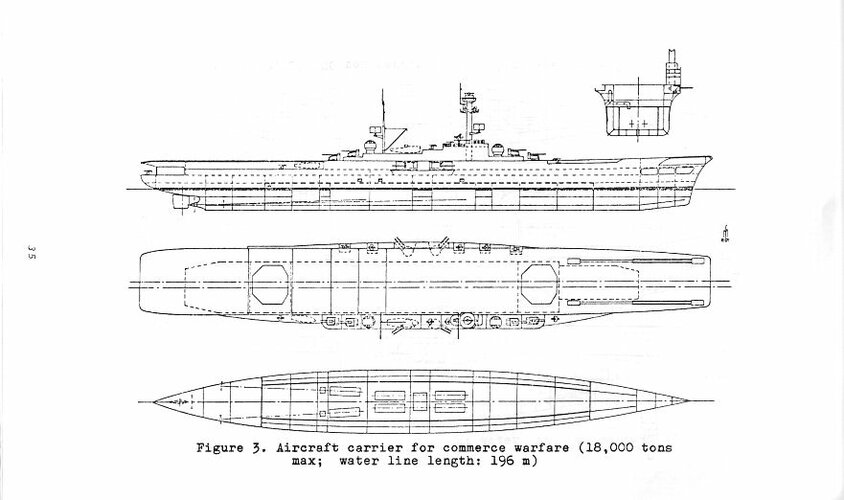
21.000ton design:

Aircraft Carrier A I / Project Flugzeugträger A I:
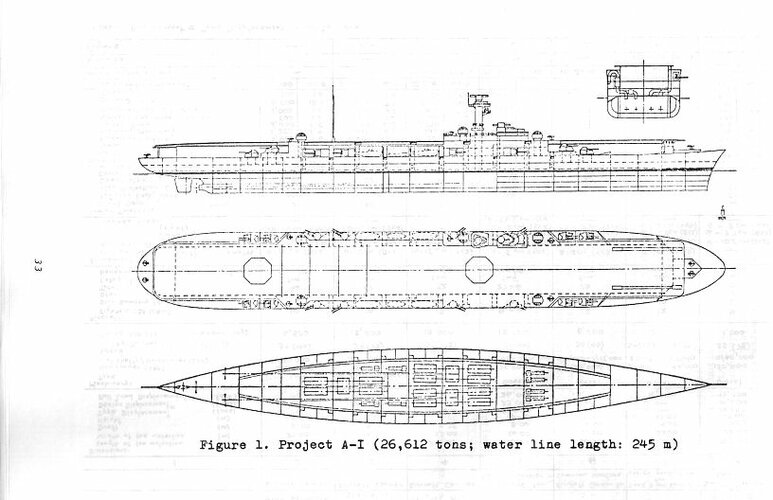
Ausonia:
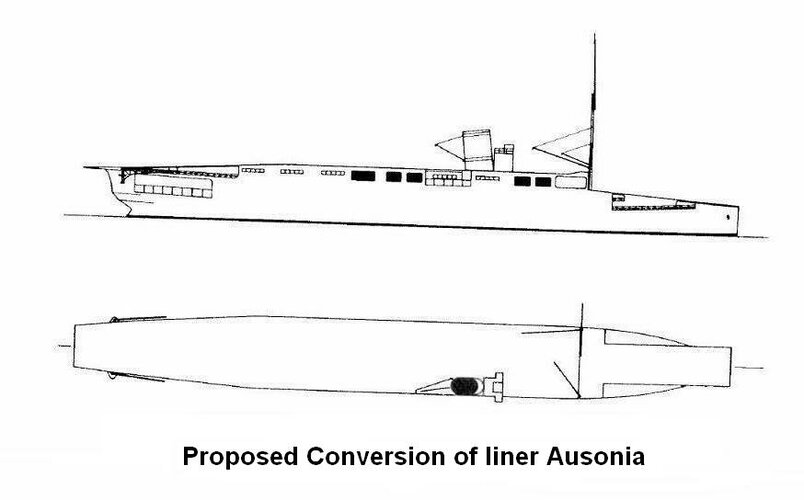
De Grasse / Project Hilfsflugzeugträger II:

Project Europa:
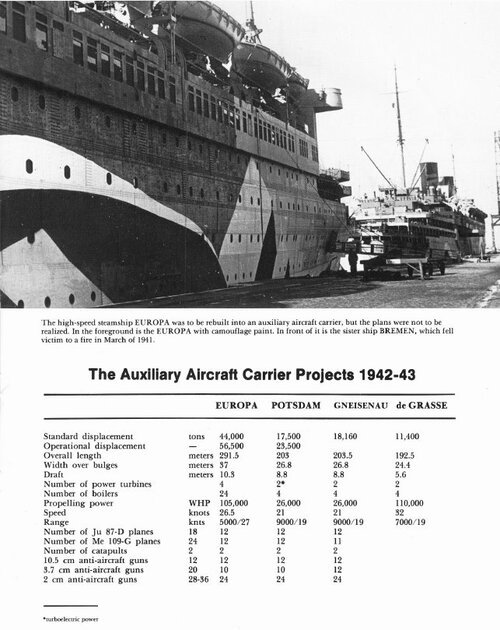
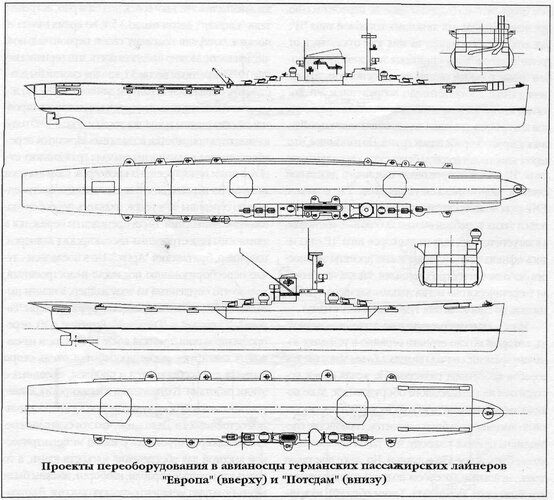
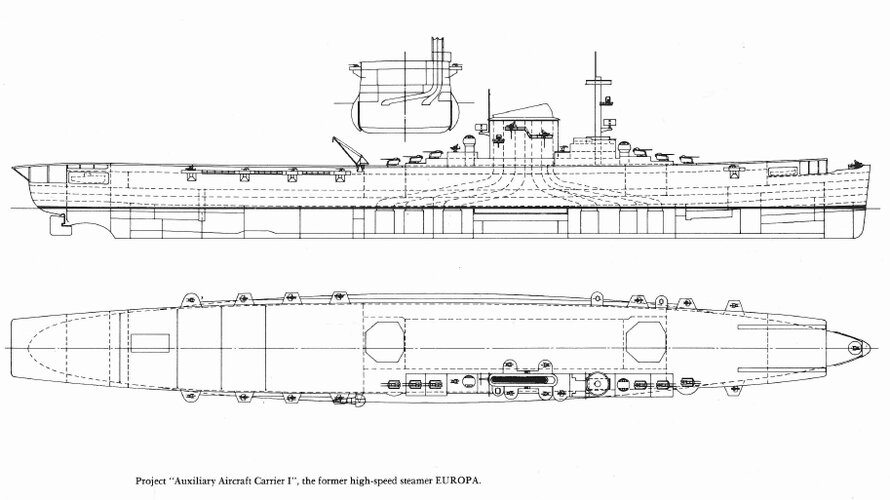
Flugzeugkreuzer A IIa:
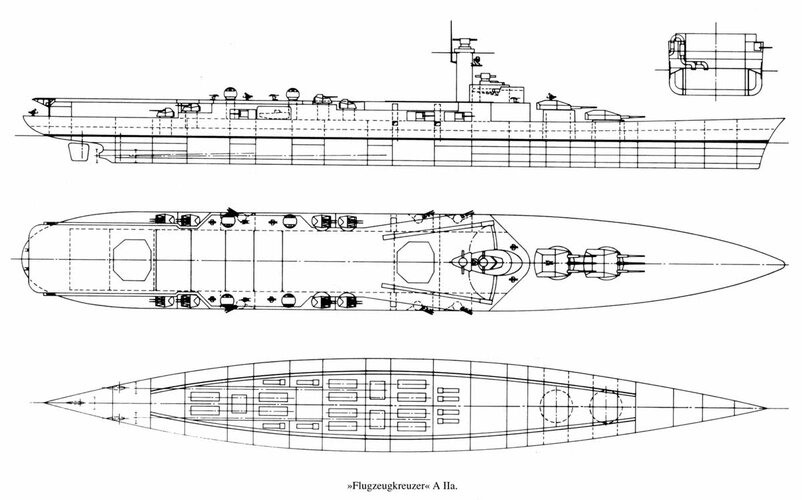
Flugzeugkreuzer A II:
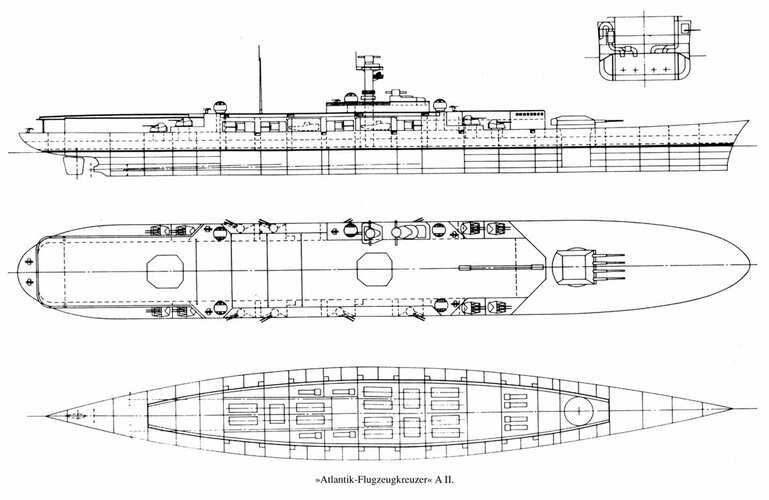
Flugzeugkreuzer A III:
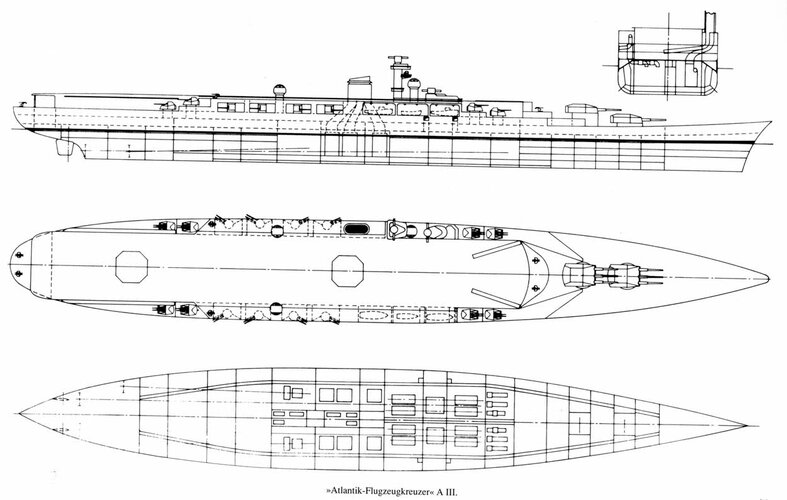
Flugzeugkreuzer A IV:
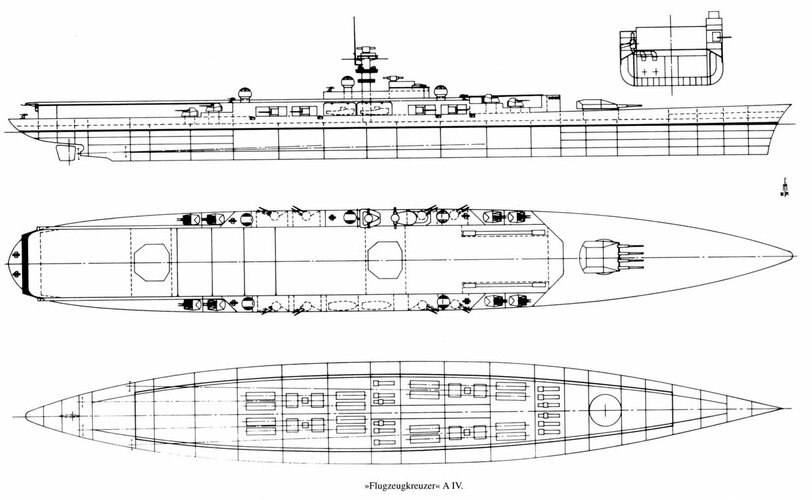
Grossflugzeugkreuzer A III:

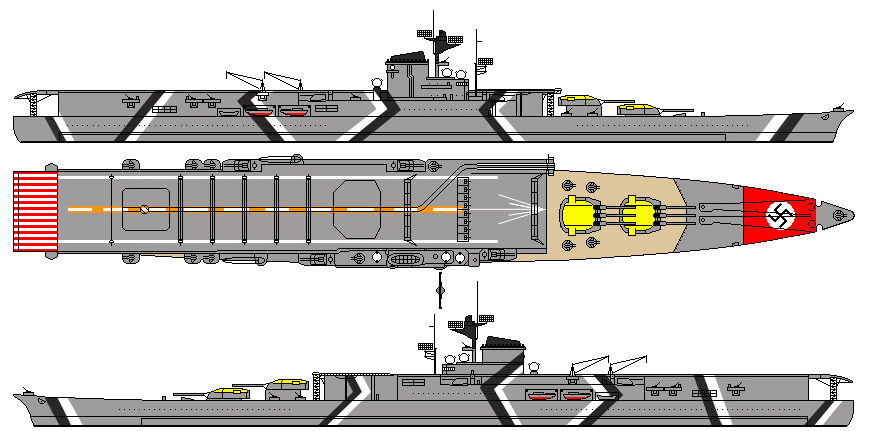
Project Kleiner Flugzeugträger A:
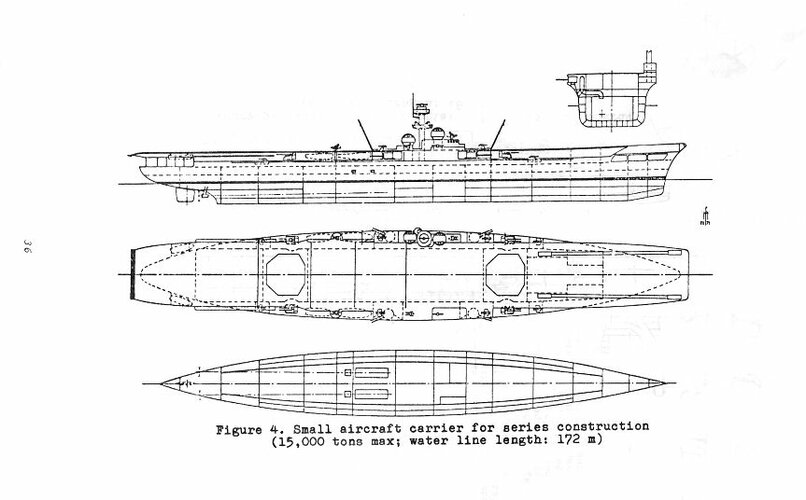
Project Kleiner Flugzeugträger B:
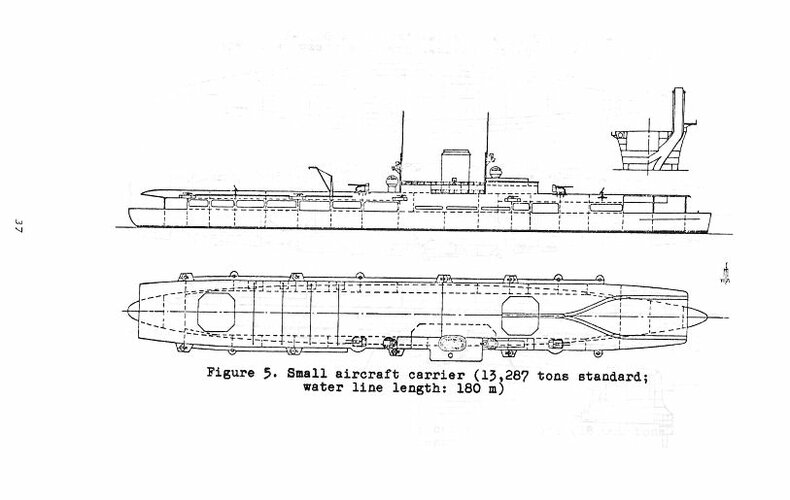
Graf Zeppelin.
Check the image attachements.
Attachments
Aircraft Carrier "C" and "D" never been designed (talked in previous threads), they were only speculated to be smaller and more cost-effective light carrier type (the mostly using to conducting long-range commerce raiding, which led to heavy use of diesel engines).
The 21000, 15000, 12000 and even smaller commerce carriers are reflected to that.
Funny, there's one design "C" variant from Large Atlantic Carrier "A III" (this doesn't matter according to committees because none of these projects are serious), which have double amount of aircraft (60 vs 32) by removing belt armor, reducing some protection elsewhere.
The 21000, 15000, 12000 and even smaller commerce carriers are reflected to that.
Funny, there's one design "C" variant from Large Atlantic Carrier "A III" (this doesn't matter according to committees because none of these projects are serious), which have double amount of aircraft (60 vs 32) by removing belt armor, reducing some protection elsewhere.
- Joined
- 1 February 2011
- Messages
- 2,929
- Reaction score
- 3,594
From Wiki:
 en.wikipedia.org
The ship's flight deck was 276 m (906 ft) long and 30 m (98 ft) wide. There was a single hangar that was 216 m (709 ft) long, 25 m (82 ft) wide forward, and 30 m (98 ft) wide aft. No armor was to have been added to the ship during the conversion process.[6]
en.wikipedia.org
The ship's flight deck was 276 m (906 ft) long and 30 m (98 ft) wide. There was a single hangar that was 216 m (709 ft) long, 25 m (82 ft) wide forward, and 30 m (98 ft) wide aft. No armor was to have been added to the ship during the conversion process.[6]
Source:
Gröner, Erich (1990). German Warships: 1815–1945. Vol. I: Major Surface Vessels. Annapolis: Naval Institute Press. ISBN 978-0-87021-790-6.
German aircraft carrier I (1942) - Wikipedia
Source:
Gröner, Erich (1990). German Warships: 1815–1945. Vol. I: Major Surface Vessels. Annapolis: Naval Institute Press. ISBN 978-0-87021-790-6.
Force Lord
ACCESS: Restricted
- Joined
- 13 December 2020
- Messages
- 17
- Reaction score
- 12
Best I could find is from this Russian site: http://seawarpeace.ru/deutsch/flug/01_main/03_21.htmlDo you have more detailed blueprints of the 21000t design of aircraft carrier?
lukasgrul
ACCESS: Confidential
- Joined
- 15 May 2021
- Messages
- 129
- Reaction score
- 112
I don´t know much about it but I think that it is an ordinary FL-22 catapult found on other german ships like Admiral Hipper class, Deutschland class atc. I think that same catapult was to be on Graf Zeppelin also. Only picture I have is that from Graf Zeppelin, but I will try to find it for you.
Attachments
lukasgrul
ACCESS: Confidential
- Joined
- 15 May 2021
- Messages
- 129
- Reaction score
- 112
_Sarcasticat_
Die Katze.
- Joined
- 16 April 2020
- Messages
- 364
- Reaction score
- 351
I believe that is Flugzeugtrager C/D, which were intended to have diesel to provide them additional range after it was realized the initial range estimates for Graf Zeppelin's steam system were way too high. Maybe it would be more accurate to say that this is a resdesign for GZ that could best be applied for GZ carriers after FZT B, though I would see no problem in providing B with diesel power given the delays in her construction compared to GZ.Do you know anything about redesigned Graf Zeppelin that is in this chart?
_Sarcasticat_
Die Katze.
- Joined
- 16 April 2020
- Messages
- 364
- Reaction score
- 351
I would suggest The German Aircraft Carrier GRAF ZEPPELIN by Siegfried Breyer, which mentions the Deutschland and Scharnhorst/Gneisenau conversions but there is no other information about them that I am aware of.I haven't read much on the Deutschlands and I haven't heard about this rebuild proposal, do you by any chance know where I can find more details?
No, but the text does detail that the capacity for aircraft would increase to 38 bombers and 12 fighters (from 12 fighters and 20 bombers in the turreted designs of AIII/AIV.)
Aircraft would be "Me 109 F" and "Ju 87 D".
While I must admit it seems likely they would have used A-I as a model for the "Atlantik" hybrid conversion into a full carrier, (after all, the A-II hybrid is simply a hybrid version of A-I) one might easily imagine a version with a more enclosed bow, in the manner of the 15,000 ton and 18,000 ton ships.
Is there any chance that you could provide a longer excerpt from Whitley?
DRW
Attachments
_Sarcasticat_
Die Katze.
- Joined
- 16 April 2020
- Messages
- 364
- Reaction score
- 351
Lilienthal is referenced in Whitley's German Capital Ships of WWII, in the Graf Zeppelin section. Outside of this sole reference, I have not seeing anything else regarding the "Lilienthal". However, given the stats provided, it must have been at least somewhat sketched out. There is probably a design of it somewhere, if it survives. I'm rather certain one was at least made.Been looking at the Marinearchiv forum despite my complete lack of knowledge in German and having to rely on Google Translate on all things, but on this thread from 2013 I saw something that got me curious. Here's the original German, by the user RePe:
And here translated to English by Google's best efforts:
The bolded part is what got my attention. Can anyone corroborate what Whitley said?
_Sarcasticat_
Die Katze.
- Joined
- 16 April 2020
- Messages
- 364
- Reaction score
- 351
"The design for the 'Grosseflugzeugkreuzer' (project AI and AII) envisaged a 40,000-tonne ship with a three-shaft 210,000hp machinery installation and capable of 34 knots. This incorporated a hangar 160m long and could accommodate 12 fighters and 16 bombers. A gun armament of four 20.3cm, sixteen 15cm and sixteen 10.5cm was provided, which the 15cm still being shipped in casemates. Armoring was fairly extensive, totaling 9,000 tonnes with a 150mm main belt and 60-100mm armored deck. A variation of this project was a modification as a true aircraft-carrier with the 20.3cm guns being omitted and a consequent increase in the aircraft capacity. The hangar length was increased to 210m, allowing the operation of 26 bombers and 12 fighters. The dimensions, engines and hull were to be identical to the Grossflugzeugkreuzer, but with the omission of the heavy guns the weight breakdowns were differently arranged. This design was referred to as the Grossflugzeugtrager.While I must admit it seems likely they would have used A-I as a model for the "Atlantik" hybrid conversion into a full carrier, (after all, the A-II hybrid is simply a hybrid version of A-I) one might easily imagine a version with a more enclosed bow, in the manner of the 15,000 ton and 18,000 ton ships.
Is there any chance that you could provide a longer excerpt from Whitley?
DRW
An even larger project was the 'Atlantikflugzeugkreuzer' (projects AIII and AIV) which displaced about 70,000 tonnes, carrier 38 aircraft and was armed with four or six 28cm guns! With armored deck and flight deck up to 150mm thick and a waterline belt of 250mm, this was indeed a heavily protected vessel. Once again a modification of the sketch design was a true aircraft-carried layout, which, by the omission of the 28cm guns, allowed the aircraft complement to rise to 38 bombers and 12 fighters."
I can see the encased fore ends for the lighter ships, but wonder about the bigger ones. Either way, I suspect the AII-AIVs would not have had it, given AI did not either.
IJN Yamato BB17
In the rabbit hole of obscure KMS Aircraft Carrier
- Joined
- 17 November 2023
- Messages
- 2
- Reaction score
- 2
The only attempt I've seen to put picture to words for the Scharnhorst Class Carrier Conversion is Karle94.
Its funny that both Germany and Japan proposed to convert their capital ships into carriers. Japan it was the Kongos, Fuso's and Ise's Germany it was the Deutschland's and Scharnhorst's. However these conversions would only be a hinder to both.
Chasing down ever possible/blueprint German Aircraft Carrier design is exhausting as I have yet to see anyone bring everything together in one place.
Its funny that both Germany and Japan proposed to convert their capital ships into carriers. Japan it was the Kongos, Fuso's and Ise's Germany it was the Deutschland's and Scharnhorst's. However these conversions would only be a hinder to both.
Chasing down ever possible/blueprint German Aircraft Carrier design is exhausting as I have yet to see anyone bring everything together in one place.
My reading of Breyer (pg 34) is that the conversions of Lützow/Scheer and Scharnhorst/Gneisenau were only briefly considered before being rejected. I certainly haven't seen these elsewhere.I would suggest The German Aircraft Carrier GRAF ZEPPELIN by Siegfried Breyer, which mentions the Deutschland and Scharnhorst/Gneisenau conversions but there is no other information about them that I am aware of.
DRW
Interesting. That suggests that the drawings for the "full carrier" version exist somewhere.An even larger project was the 'Atlantikflugzeugkreuzer' (projects AIII and AIV) which displaced about 70,000 tonnes, carrier 38 aircraft and was armed with four or six 28cm guns! With armored deck and flight deck up to 150mm thick and a waterline belt of 250mm, this was indeed a heavily protected vessel. Once again a modification of the sketch design was a true aircraft-carried layout, which, by the omission of the 28cm guns, allowed the aircraft complement to rise to 38 bombers and 12 fighters."
I can see the encased fore ends for the lighter ships, but wonder about the bigger ones. Either way, I suspect the AII-AIVs would not have had it, given AI did not either.
As mentioned above, I do think that it is likely that the "full carrier" version of A-III/A-IV would be a larger analog of A-I, at least as regards the flight deck at the bow. They seem to have liked the idea of a bridge at the bow for this series, and that precludes the sort of enclosed bow that we saw on the 15,000 and 18,000 ton ships.
In my opinion, these German designs had too little hangar and flight deck space for their size, and that is reflected in their small air wing. Anything they could do to increase the size of the hangar and flight decks would have been an improvement.
DRW
_Sarcasticat_
Die Katze.
- Joined
- 16 April 2020
- Messages
- 364
- Reaction score
- 351
This is a very annoying inaccuracy that tends to float about for German carrier aviation in general. Hangar volume is not the issue - the aircraft used are. "Plane Tetris" with Graf Zeppelin utilizing to-scale foreign aircraft shows the absolute inadequacy of converted BF-109 and Ju-87 aircraft in this context (with the exception of the Ju-87D). Even net hangar volume (actual usable area) is often in excess of foreign contemporaries.In my opinion, these German designs had too little hangar and flight deck space for their size, and that is reflected in their small air wing. Anything they could do to increase the size of the hangar and flight decks would have been an improvement.
DRW
For AIII and AIV, one could certainly make the argument that the capacity is lacking. This may be due to the fact that while GZ has two hangars, AI-AIV only have one. A careful comparison would have to be made. Interestingly, though, despite being nearly 40,000 tons heavier, AIII/IV is not much larger than GZ. This is almost certainly due to the extensive armoring, which is significantly greater than that of their predecessor.
I suspect this may have something to do with the perceived inability of Atlantic employment for Graf Zeppelin, possibly due to her height, which was the cause of this particular reaction.
I would not mind finding those full-carrier plans, should they exist.
Force Lord
ACCESS: Restricted
- Joined
- 13 December 2020
- Messages
- 17
- Reaction score
- 12
I've seen it been claimed on the WoWs forums that, besides German carrier aircraft lacking folding wings and the general reluctance of the Luftwaffe to provide aircraft for purposes they had little use for (especially when the Kriegsmarine couldn't make up its mind on what it wanted its carriers to do), part of the problem was that the spacing between aircraft was inefficient and made poor use of space, reflecting the general inexperience in carrier aircraft management and the Luftwaffe transplanting airfield and land hangar practice on to ship hangars.
EDIT: Also I doubt the Germans were aware of American practice of stowing aircraft on the roof of the carrier hangar.
EDIT: Also I doubt the Germans were aware of American practice of stowing aircraft on the roof of the carrier hangar.
_Sarcasticat_
Die Katze.
- Joined
- 16 April 2020
- Messages
- 364
- Reaction score
- 351
The initially converted aircraft did not. This is largely due to the attempt to convert land-based variants, but there was success with the Ju-87 D, which would fold extremely nicely. None of the fighters would be of a folded-wing design, possibly a limitation of the BF-109 fuselage, which was used in the BF-109T and Me-155.I've seen it been claimed on the WoWs forums that, besides German carrier aircraft lacking folding wings and the general reluctance of the Luftwaffe to provide aircraft for purposes they had little use for (especially when the Kriegsmarine couldn't make up its mind on what it wanted its carriers to do), part of the problem was that the spacing between aircraft was inefficient and made poor use of space, reflecting the general inexperience in carrier aircraft management and the Luftwaffe transplanting airfield and land hangar practice on to ship hangars.
EDIT: Also I doubt the Germans were aware of American practice of stowing aircraft on the roof of the carrier hangar.
As far as aircraft arrangement in hangars, I see no issues - they play just as much tetris as any other nation, as far as comparisons reveal. Maybe there's some sort of uber-efficient arrangement I'm missing here?
There is a 1942 carrier plan that actually has Me-155s hanging from the hangar ceiling, just as in USN practice.
YourChair
ACCESS: Confidential
- Joined
- 24 October 2021
- Messages
- 83
- Reaction score
- 138
Germans usually did not need to store aircraft on the roof of the carrier hangar because their carriers (at least Graf Zeppelin) were designed on the Japanese model, with a double hangar.I've seen it been claimed on the WoWs forums that, besides German carrier aircraft lacking folding wings and the general reluctance of the Luftwaffe to provide aircraft for purposes they had little use for (especially when the Kriegsmarine couldn't make up its mind on what it wanted its carriers to do), part of the problem was that the spacing between aircraft was inefficient and made poor use of space, reflecting the general inexperience in carrier aircraft management and the Luftwaffe transplanting airfield and land hangar practice on to ship hangars.
EDIT: Also I doubt the Germans were aware of American practice of stowing aircraft on the roof of the carrier hangar.
lukasgrul
ACCESS: Confidential
- Joined
- 15 May 2021
- Messages
- 129
- Reaction score
- 112
If anybody is interested, here are some carriers that I drew in shipbucket style.
Attachments
_Sarcasticat_
Die Katze.
- Joined
- 16 April 2020
- Messages
- 364
- Reaction score
- 351
Well doneFew days ago I finished a drawing of 21000t aircraft carrier project.

